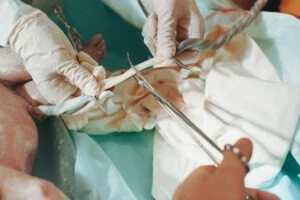
Umbilical cord prolapse is a rare but serious complication that can occur during labor and delivery. It happens when the umbilical cord drops through the cervix into the vagina before the baby, potentially cutting off the baby’s oxygen supply.
This condition requires immediate medical attention to prevent serious harm to the baby. If you or your baby have been affected by umbilical cord prolapse, especially if you suspect medical negligence played a role, our Arizona umbilical cord birth injury lawyers can help. Let’s explore this condition in more detail.
What Are the Types of Umbilical Cord Prolapse?
There are three main types of a prolapsed cord:
- Overt prolapse: This is when the umbilical cord descends past the presenting part of the baby and can be felt or seen in the vagina. This is the most dangerous type and requires immediate action.
- Occult prolapse: In this case, the cord is alongside the presenting part of the baby but isn’t visible. It’s harder to diagnose but can still cause complications.
- Funic presentation: This occurs when the umbilical cord is between the baby’s presenting part and the cervix, but the membranes haven’t ruptured yet. When the membranes rupture, it can potentially lead to overt prolapse.
"If your child was born with a birth injury, or cerebral palsy, we can help."
What Causes Umbilical Cord Prolapse?
Several things can contribute to an umbilical cord prolapse:
- Premature rupture of membranes: If your water breaks before the baby is engaged in the pelvis, it can allow the cord to slip down.
- Breech or transverse position: When the baby isn’t in a head-down position, there’s more space for the cord to descend.
- Multiple pregnancies: Twins or other multiples increase the risk because there are more umbilical cords.
- Excessive amniotic fluid: Too much fluid can allow more room for the cord to move.
- Preterm labor: Babies born early are at higher risk.
- Artificial rupture of membranes: In some cases, medical interventions can inadvertently lead to prolapse.
A prolapsed cord can lead to serious complications, primarily due to the compression of the cord, cutting off the baby’s oxygen supply. Potential complications include:
- Birth asphyxia: Lack of oxygen can lead to brain damage or other organ damage.
- Cerebral palsy: In severe cases, oxygen deprivation can result in this lifelong condition.
- Developmental delays: Even brief periods of reduced oxygen can impact a child’s development.
- Stillbirth: In the most severe cases, if not addressed quickly, umbilical cord prolapse can be fatal for the baby.
Who Is at Risk for Umbilical Cord Prolapse?
While umbilical cord prolapse can happen in any pregnancy, certain factors increase the risk:
- Women carrying multiples (twins, triplets, etc.)
- Pregnancies with excessive amniotic fluid (polyhydramnios)
- Premature labor or rupture of membranes before 37 weeks
- Breech or transverse presentations
- Grand multiparity (having given birth many times before)
- Pregnancies with a very long umbilical cord
- Low birth weight babies
If you have any of these risk factors, your healthcare provider should discuss them with you and explain any necessary precautions they’ll take against umbilical cord prolapse. If they fail to take precautions, you may have grounds for a malpractice lawsuit. Speak with a birth injury lawyer if you’re not sure.
"We know first-hand what you are going through."
What Should I Do If I Suspect Umbilical Cord Prolapse?
Umbilical cord prolapse is a medical emergency. If you suspect umbilical cord prolapse, it’s crucial to act quickly:
- Call for help immediately: Alert your healthcare provider or emergency services if you’re not in a hospital.
- Get into a knee-chest position: This can help reduce pressure on the cord.
- Don’t try to push the cord back in: This could cause further complications.
- Stay calm: While it’s a scary situation, try to remain as calm as possible to allow for quick action.
"Our Birth Injury Lawyers have recovered over $750+ Million on behalf of our clients."
What Is the Prognosis for Babies Affected by Umbilical Cord Prolapse?
The prognosis for babies affected by umbilical cord prolapse largely depends on how quickly the situation is recognized and addressed. With prompt medical intervention, many babies do well.
If the prolapse is quickly identified and the baby is delivered promptly, there may be no long-term effects. Some babies may experience temporary issues that resolve with time and treatment.
In situations where there is significant oxygen deprivation, babies may face long-term challenges such as cerebral palsy or developmental delays.
How Can Medical Negligence Contribute to Umbilical Cord Prolapse Complications?
While many cases of umbilical cord prolapse are handled expertly by medical professionals, sometimes negligence can contribute to complications. Examples include:
- Failure to identify risk factors: If healthcare providers don’t recognize and prepare for high-risk situations.
- Delayed diagnosis: If signs of prolapse are missed or ignored.
- Improper management: If appropriate steps aren’t taken quickly once prolapse is identified.
- Inadequate monitoring: If the baby’s heart rate isn’t properly monitored during labor.
- Unnecessary interventions: In some cases, improper use of medical techniques might increase the risk of prolapse.
If you believe medical negligence played a role in your or your baby’s umbilical cord prolapse complications, it’s important to seek legal advice. Don’t hesitate to reach out if you have questions or concerns about your experience with umbilical cord prolapse.
Our team is here to provide compassionate support and legal guidance. Learn more about our firm today in a free consultation. We can discuss your case and explore how we can help you seek compensation for medical malpractice.
"We are committed to helping families who have suffered medical negligence."

